The UN Climate Change Conferences are important events. Thousands of people meet to influence, discuss and agree on the current status and new activities for the future of climate change action. Many of the organisers are here in Bonn, a UN City that hosts over 1000 United Nations staff. Bonn is also where SISTRIX does all its work so in the spirit of helping neighbors we’re sharing SEO data and analysis to help content planners with their work.
In this article you’ll find data based on a curated keyword set of over 800 search terms. We’re sharing clusters, leading domains and the most visible articles in the sector. This data will help content creators understand, organise, target and craft their climate change content, just as Google likes it. The methodology is shown below.
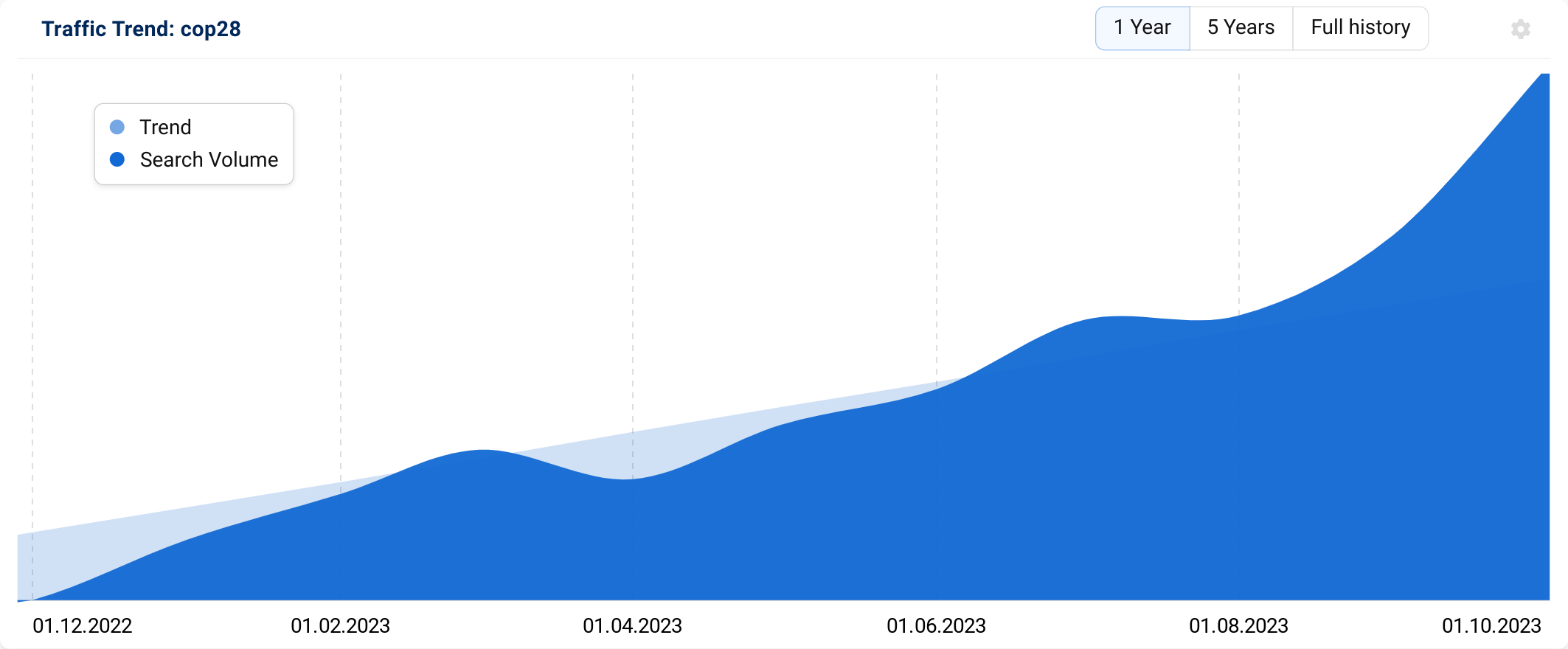
A bucket of climate keywords
By starting with a curated keyword set you can reduce any bias that is introduced when trying to brainstorm websites and keywords. Often the websites and brands that you think of are not the only ones that are competing for traffic in Google search.
Our list contains over 800 keywords and has a total average per month search volume in the UK of over 450000 making it a large and relevant set. The full keyword set is available for download at the end of this article. The methodology is also shared below.
The top domains for climate change topics
After harvesting, re-harvesting and curation of the keyword set we can look across the SERPs and evaluate the domains, and their positions within them. It takes a lot of time to do this by hand so we’ve used the built-in list processing feature in SISTRIX. The Top 50 domains for this keyword set, weighted by positioning and search volume, are shown below. The process was done both at the start, and at the end of the COP28.
| Domain | Project Visibility Index | Pos 13 Dec 2023 | Pos 29 Nov 2023 | Change | Project top 10 rankings |
|---|---|---|---|---|---|
| wikipedia.org | 494.06 | 1 | 1 | 0 | 394 |
| nasa.gov | 292.05 | 2 | 3 | 1 | 203 |
| un.org | 288.96 | 3 | 2 | -1 | 217 |
| europa.eu | 272.15 | 4 | 4 | 0 | 213 |
| unfccc.int | 242 | 5 | 5 | 0 | 189 |
| epa.gov | 202.59 | 6 | 6 | 0 | 149 |
| nationalgrid.com | 168.08 | 7 | 8 | 1 | 116 |
| nrdc.org | 139.59 | 8 | 12 | 4 | 122 |
| cambridge.org | 135.5 | 9 | 7 | -2 | 84 |
| britannica.com | 117.44 | 10 | 10 | 0 | 115 |
| unep.org | 116.76 | 11 | 11 | 0 | 106 |
| merriam-webster.com | 108.58 | 12 | 9 | -3 | 70 |
| bgs.ac.uk | 108.12 | 13 | 15 | 2 | 83 |
| greenpeace.org.uk | 106.56 | 14 | 14 | 0 | 71 |
| imperial.ac.uk | 105.54 | 15 | 16 | 1 | 67 |
| wwf.org.uk | 97.57 | 16 | 17 | 1 | 86 |
| www.gov.uk | 86.88 | 17 | 18 | 1 | 66 |
| nationalgeographic.org | 81.91 | 18 | 19 | 1 | 76 |
| collinsdictionary.com | 77.33 | 19 | 13 | -6 | 67 |
| dictionary.com | 67.16 | 20 | 20 | 0 | 59 |
| investopedia.com | 66.39 | 21 | 23 | 2 | 51 |
| theguardian.com | 64.52 | 22 | 26 | 4 | 50 |
| ourworldindata.org | 64.47 | 23 | 24 | 1 | 52 |
| noaa.gov | 62.92 | 24 | 25 | 1 | 37 |
| worldbank.org | 57.7 | 25 | 21 | -4 | 45 |
| nationalgeographic.com | 57.13 | 26 | 22 | -4 | 48 |
| climate.gov | 46.02 | 27 | 31 | 4 | 36 |
| carboncredits.com | 45.09 | 28 | 36 | 8 | 24 |
| beis.gov.uk | 44.13 | 29 | 33 | 4 | 34 |
| mit.edu | 43.15 | 30 | 29 | -1 | 39 |
| sciencedirect.com | 42.61 | 31 | 28 | -3 | 36 |
| ucar.edu | 42.47 | 32 | 40 | 8 | 33 |
| youtube.com | 39.31 | 33 | 32 | -1 | 34 |
| iea.org | 39.31 | 34 | 34 | 0 | 36 |
| lse.ac.uk | 39.28 | 35 | 30 | -5 | 34 |
| iberdrola.com | 38.93 | 36 | 35 | -1 | 33 |
| linkedin.com | 37.39 | 37 | 38 | 1 | 37 |
| bbc.com | 36.65 | 38 | 45 | 7 | 33 |
| vocabulary.com | 35.18 | 39 | 27 | -12 | 37 |
| bbc.co.uk | 35.18 | 40 | 48 | 8 | 30 |
| energysavingtrust.org.uk | 34.21 | 41 | 47 | 6 | 29 |
| wri.org | 33.68 | 42 | 44 | 2 | 33 |
| c2es.org | 32.57 | 43 | 49 | 6 | 27 |
| imf.org | 32.32 | 44 | NEW | NEW | 32 |
| worldwildlife.org | 32.08 | 45 | NEW | NEW | 28 |
| mckinsey.com | 32.05 | 46 | NEW | NEW | 31 |
| ipcc.ch | 31.73 | 47 | 43 | -4 | 22 |
| eia.gov | 31.7 | 48 | 41 | -7 | 30 |
| facebook.com | 31.4 | 49 | NEW | NEW | 34 |
| publishing.service.gov.uk | 31.1 | 50 | 50 | 0 | 24 |
This evaluation is updating daily in SISTRIX and we’ll provide updates if major changes are seen.
As it stands now, Wikipedia is leading. At #3 the main UN domain appears to be cannibalizing the UNFCC organisation, which is at #5. The US space agency’s climate site at https://climate.nasa.gov/ is at #2 in the UK data.
Search trends from the climate change sector
Using data from the SISTRIX TrendWatch project we’ve identified a number of recent trends in the keyword set.
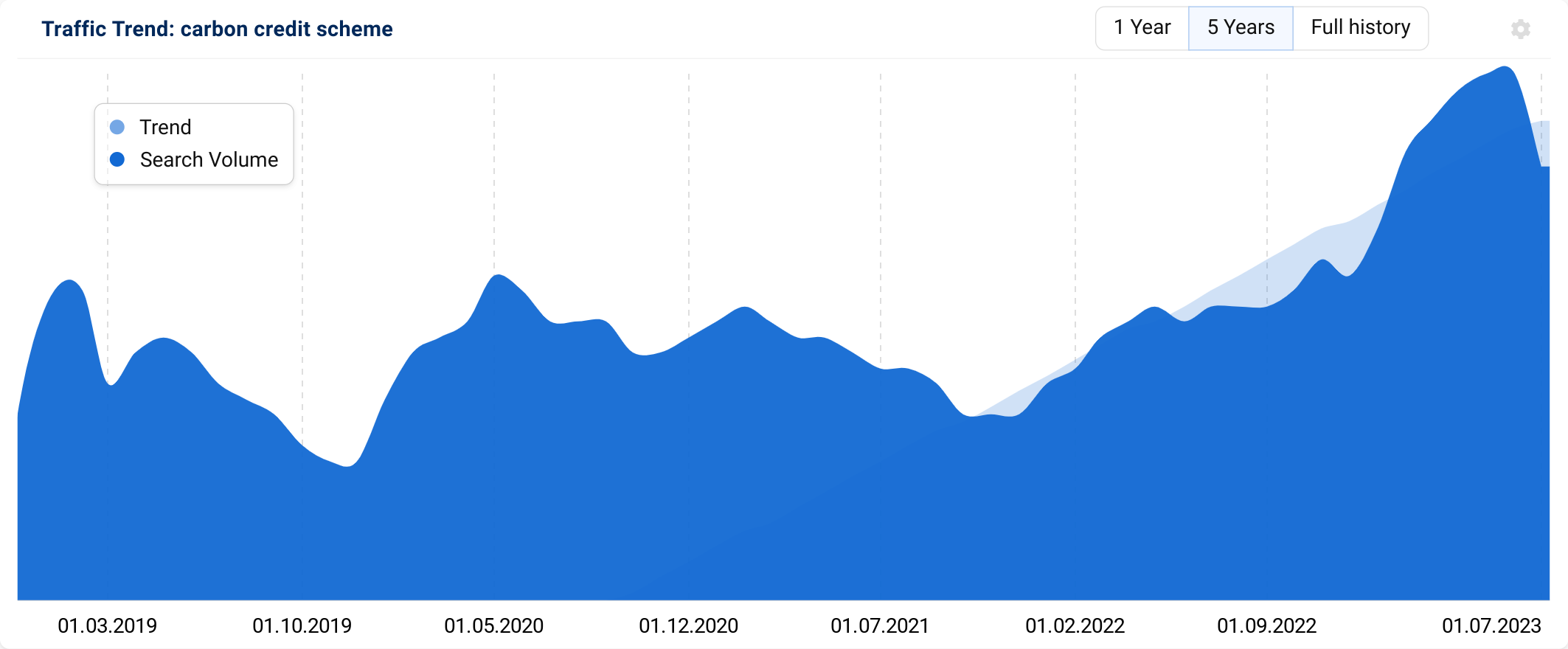
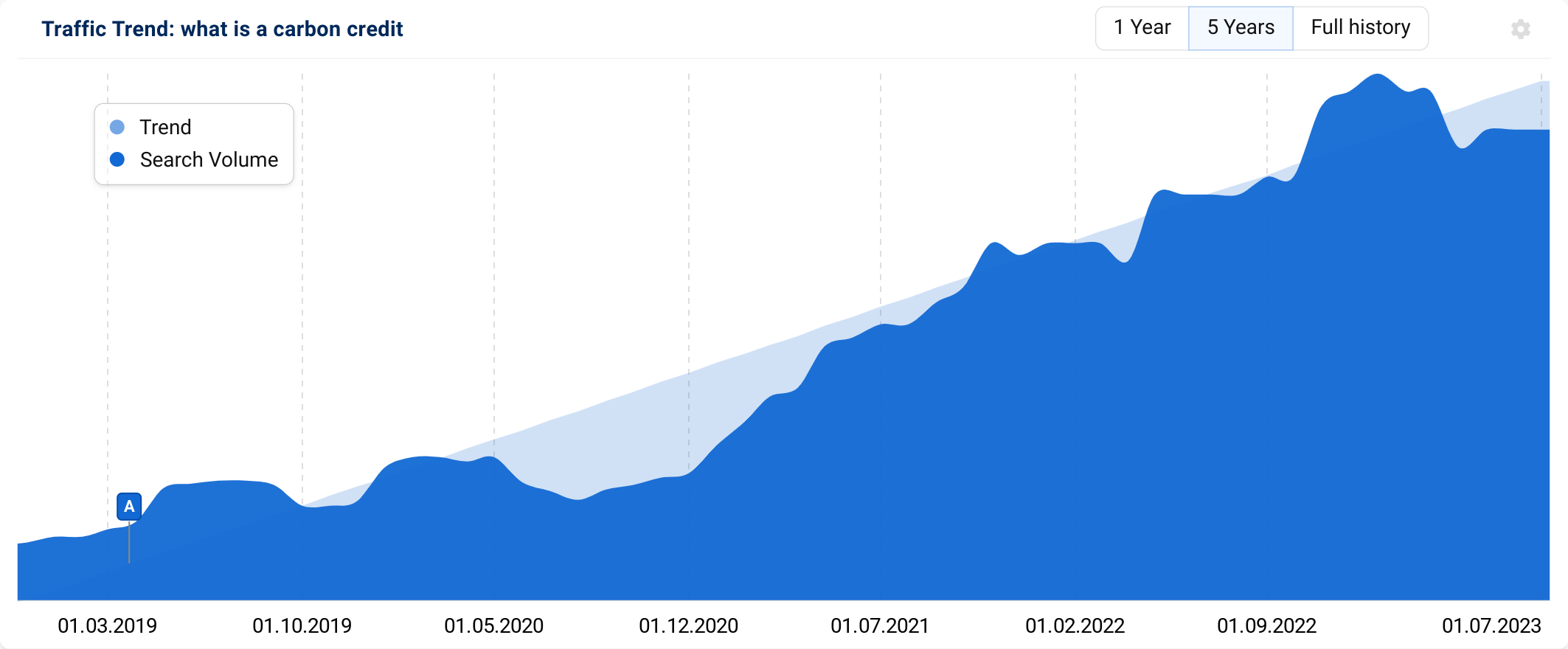
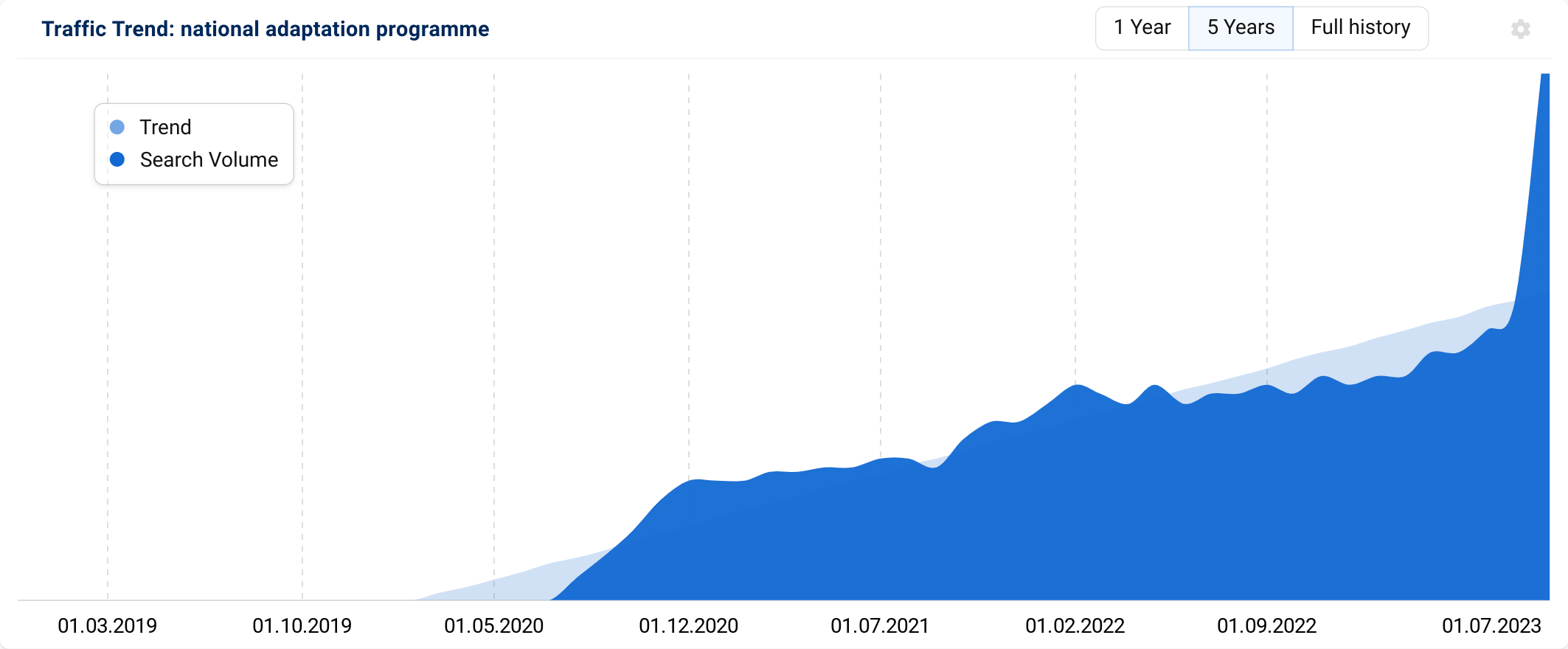
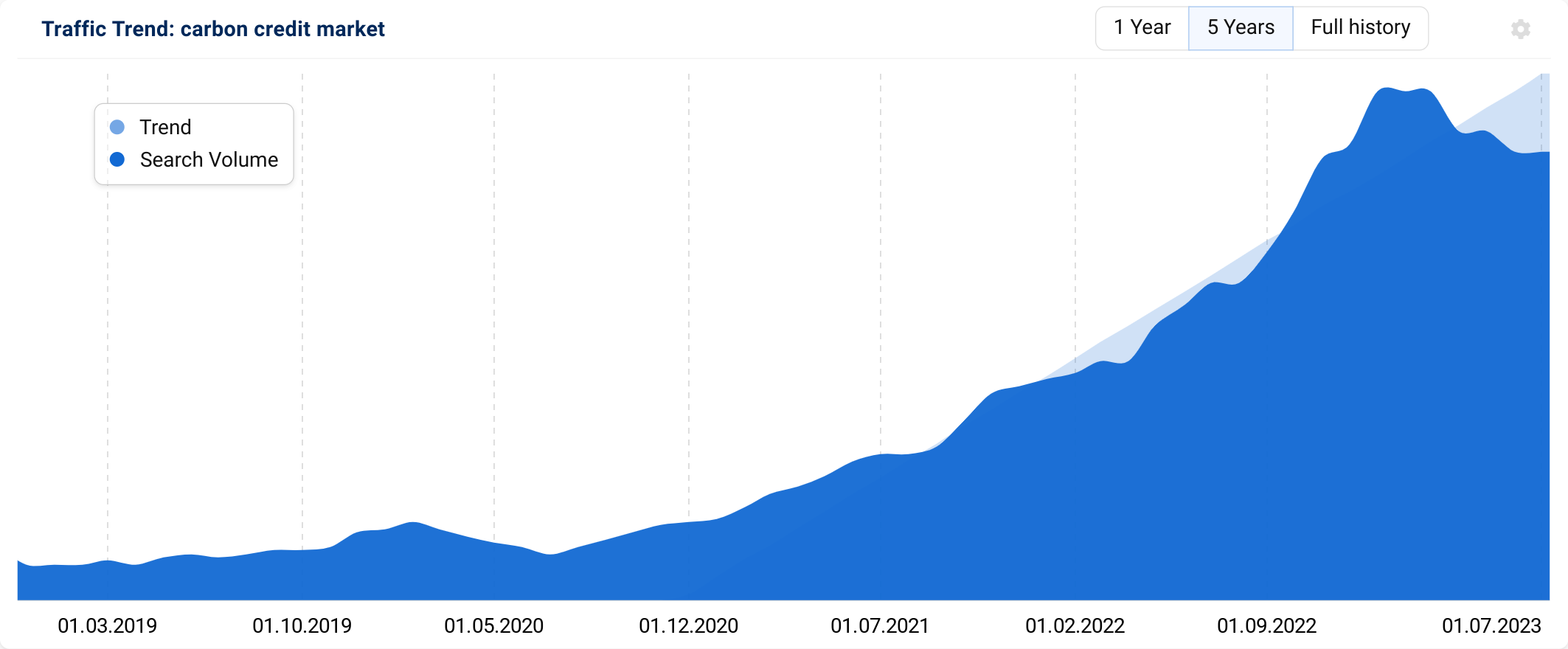
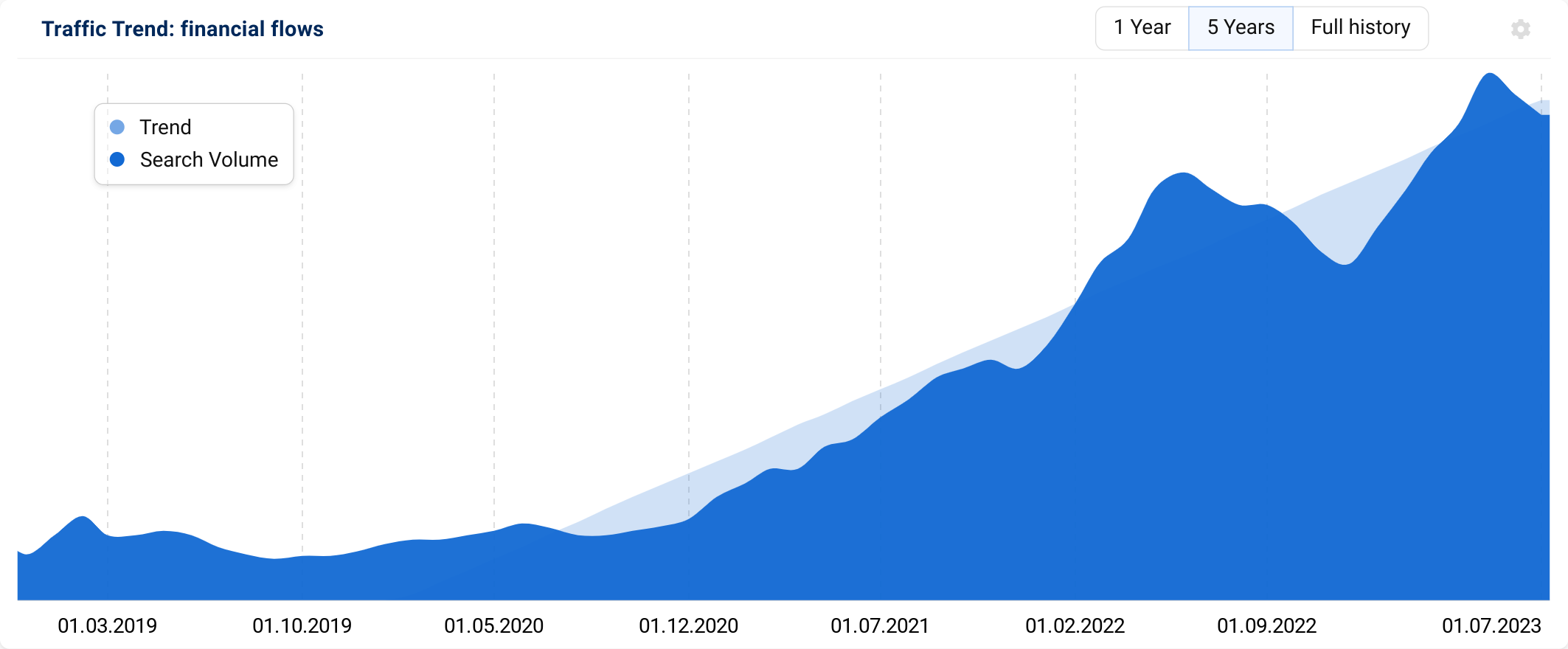
The top URLs for climate change topics
The top URLs list is a chance for everyone to learn about what Google wants. The list shows the top URLs based on the assessment (weighting of position and search volume) of the keywords that they rank for. The evaluation is included in the SISTRIX list processing functions.
In total we identified over 42000 URLs ranking for at least one of the keywords. The Top 100 URLs are shown in the table below.
Congratulations to National Grid for their highly visible URL. Here’s the development of the Visibility Index for that URL since it started ranking in 2021:
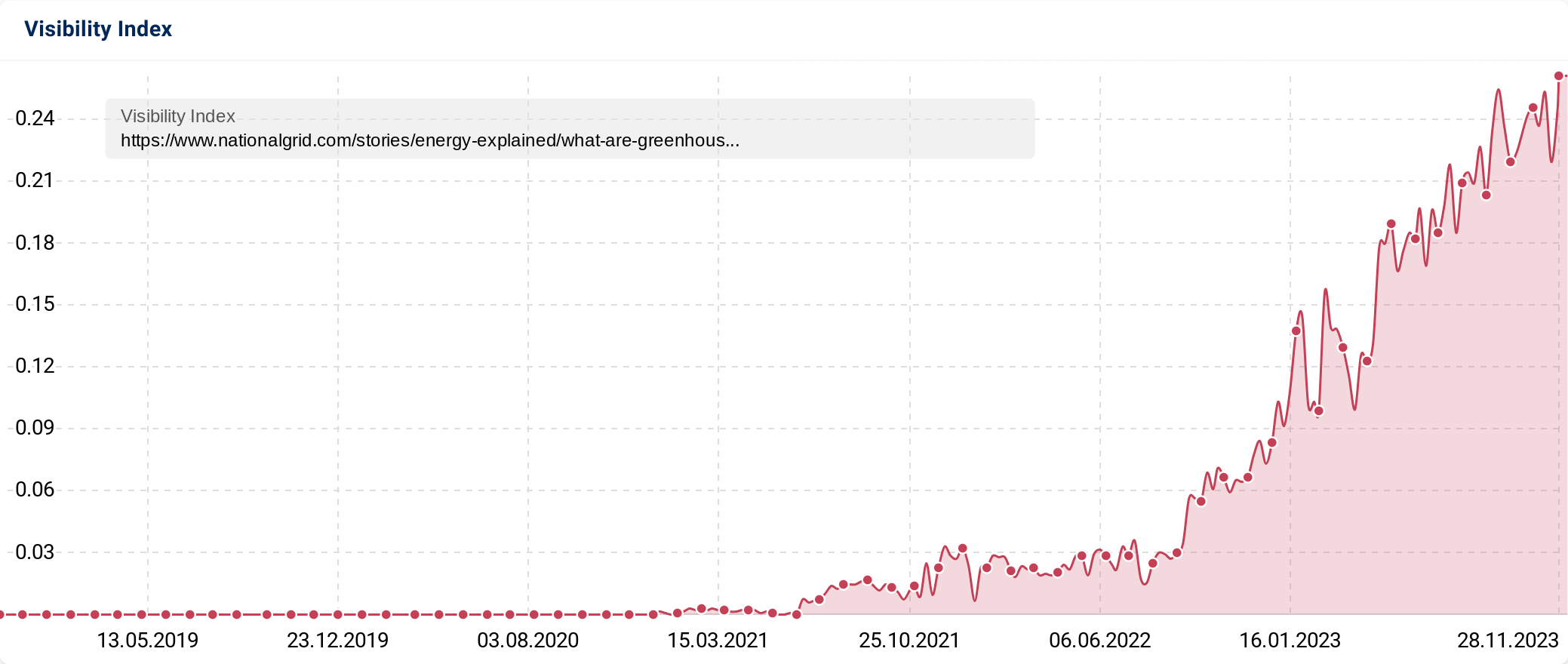
The Visibility Index shows stable growth to a value of 0.2613. This might sound like a low figure, but it’s bigger than the total visibility of 99% of all websites in our UK data set. The visibility is the result of a large informational content project under https://www.nationalgrid.com/stories/.
For more leading content from other sectors, see our Visibility Leaders project and our SectorWatch publications.
Key topic clusters in the keyword set
Using the SISTRIX auto-cluster feature, the following topics are shown as clusters.
| Cluster name | Number of keywords | Total monthly search volume | 5-year traffic trend |
|---|---|---|---|
| greenhouse effect | 107 | 213060 | flat |
| ghg (greehouse gases) | 97 | 68181 | flat |
| prevent climate change | 86 | 46000 | flat |
| what is mitigation | 56 | 9791 | flat |
| net zero | 42 | 75235 | rising |
| carbon emissions | 39 | 16388 | flat |
| how to stop climate change | 33 | 14771 | flat |
| carbon ofsetting | 33 | 29664 | flat |
| co2 emissions | 32 | 45293 | flat |
| carbon credit | 28 | 19002 | rising |
The keywords are all from the UK search database and include mobile and desktop searches. More detail is available in the SISTRIX Lists cluster feature.
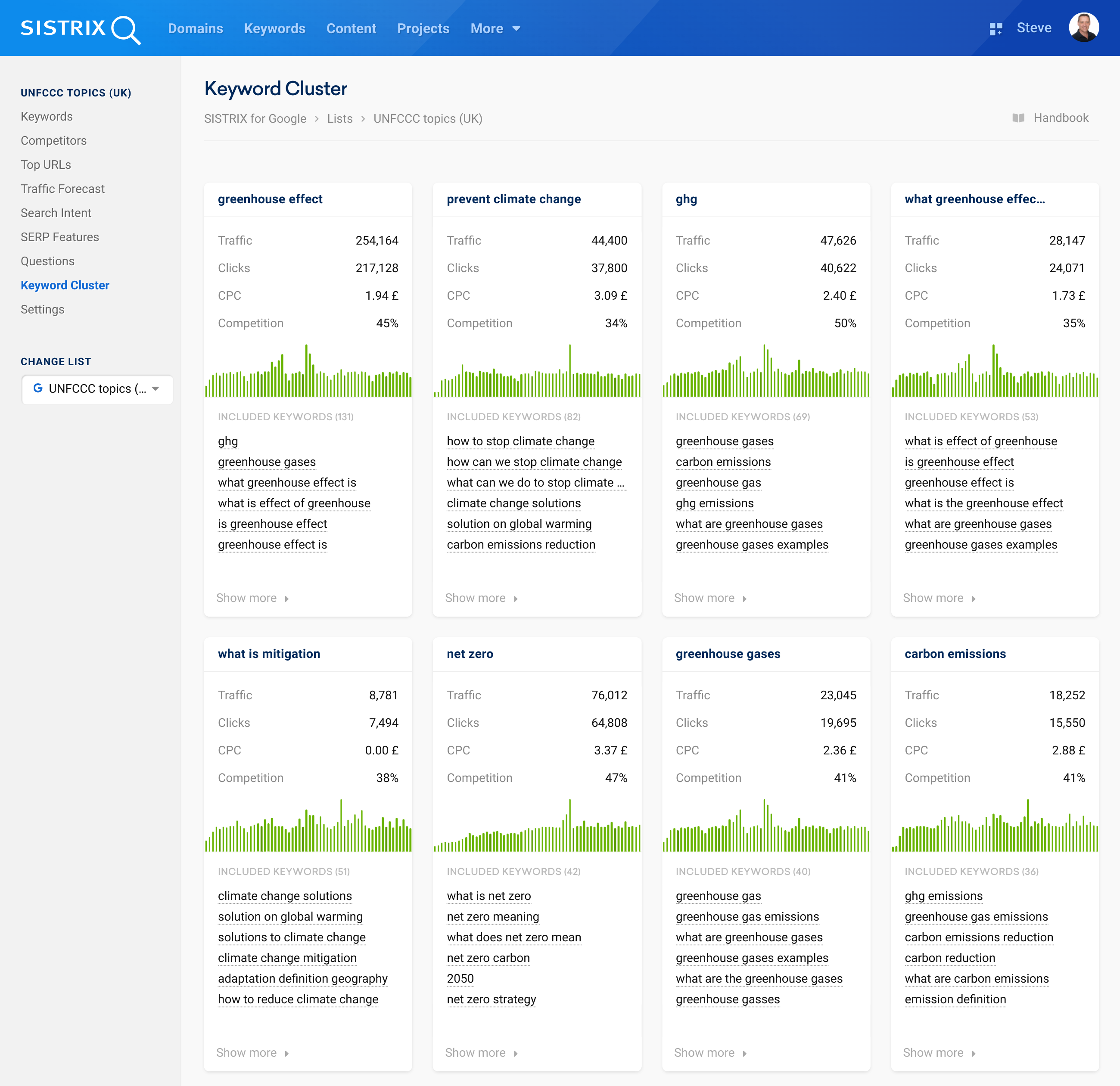
Intent and SERP features
Most of the keywords in the list have an informational, or ‘KNOW’ search intent. This analysis is based on the features that appear in the SERPs.
Videos appear in one quarter of the results.
Also appearing are Knowledge Panel boxes, Google Scholar boxes and, in 99 cases, a Google app box. In all cases tested this was Google’s dictionary application.
The features “People also search for” and “People also ask” (PAA) are the most prominent, followed by images, which appear in three-quarters of the results.
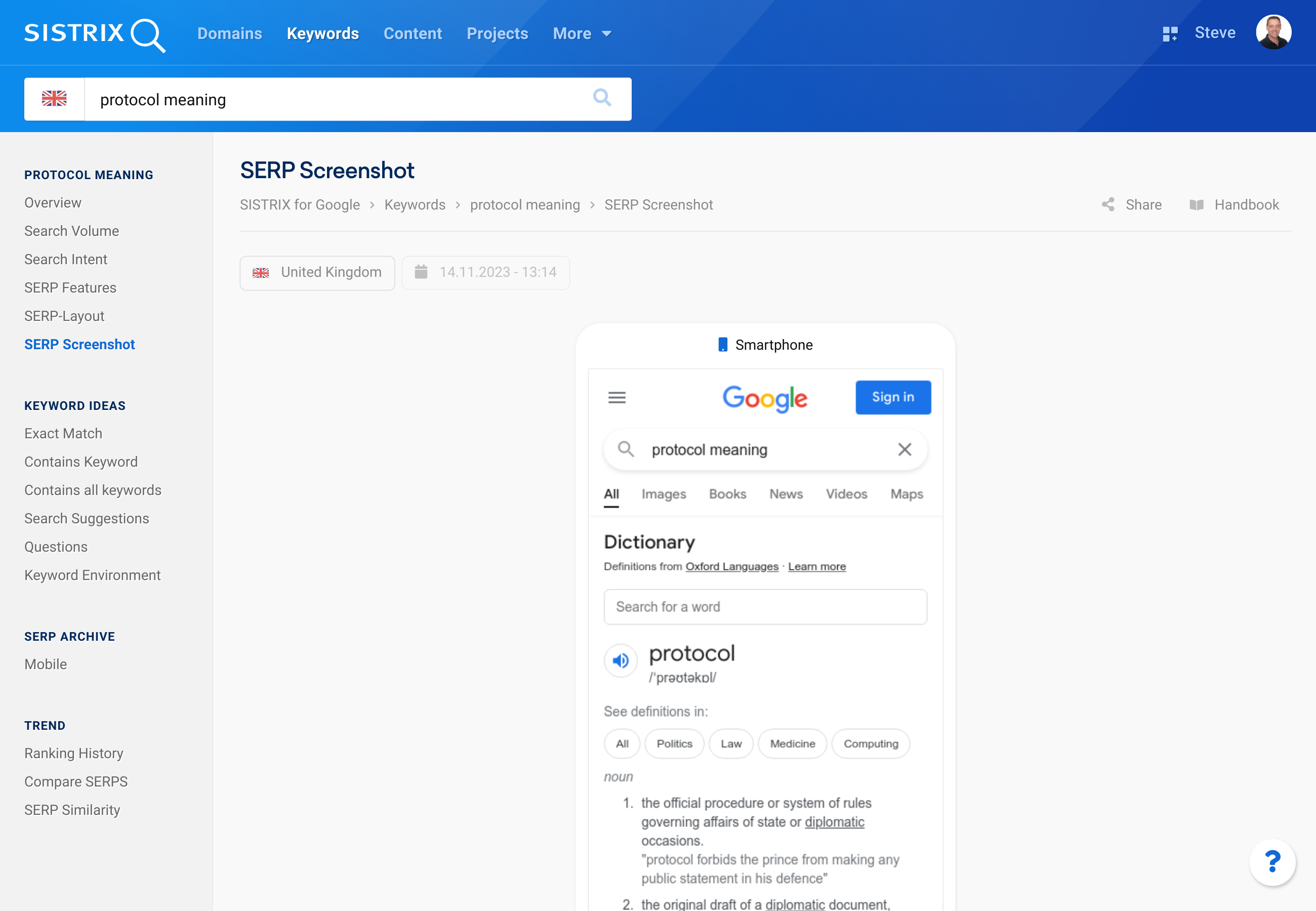
There were very few indications of commercial “DO” intent seen in the results.
News media in the environment
SISTRIX tracks organic search results, not Google features such as Discovery or News, where many news media sites get lots of traffic from Google. News media sites also appear in the SERPs though, especially when a topic becomes newsworthy. The image below shows a snapshot as of 28.11.2023. We reviewed the data again at the end of the conference, on the 13th December, and there was no significant change.
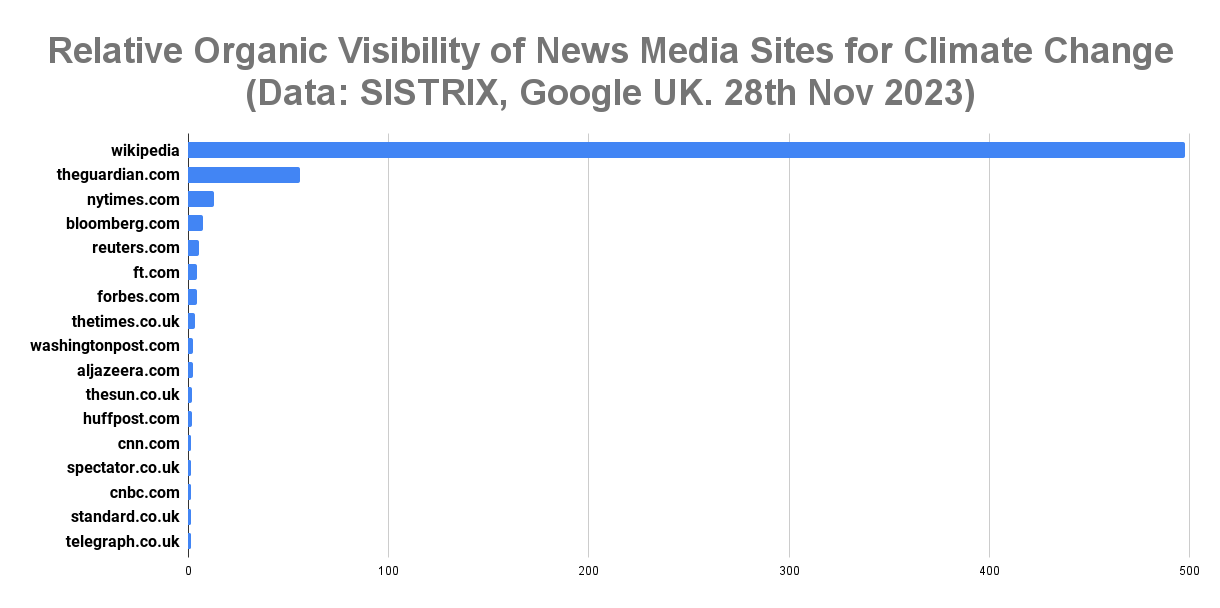
The news domains are from a tracker of over 70 that we use in our top domains analysis.
Keyword research methodology
The data here comes from the many sources and evaluations that are used in SISTRIX for our Google product. This report uses the Google UK data.
As is typical we start our keyword research process with the official source of the topics – the UNFCC website’s key informational directories – to harvest the first set of keywords.
We only used keywords for which the directories are ranking in the top 20, and only those with an average monthly search volume of 50 or more.
We then hand-curated the list to remove any brand searches and generic terms that are only loosely related to the UNFCC in search, such as “finance”. We have left in the dictionary-intent searches asking for specific climate-change terms but generic word meaning searches have been removed.
In the second stage we took keyword environments for the top 10 UNFCC-specific keywords. This includes keywords for which all the URLs in the Top 10 of the SERP are ranking and it’s a very good way to use Google to expand a keyword list.
Finally we processed the keyword list to find the Top URLs ranking for that list and we harvested from 10 of the top URLs. Again, this is a sensible way to ensure that the complete keyword environment, as used by Google, has been captured. Learn more about the basics of keyword research in our article “Keyword Research Made Easy“.
Note: All the data required is based on Googles keyword ranking and URL relationships. No other tools were used in the process.
The full keyword list is available in a Google Sheet here or as a CSV here. Feel free to take a copy, and build awareness for our neighbours’ project.
